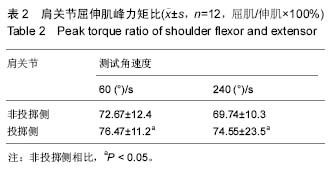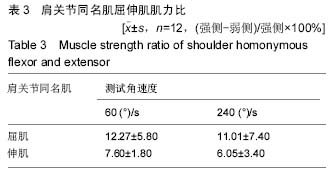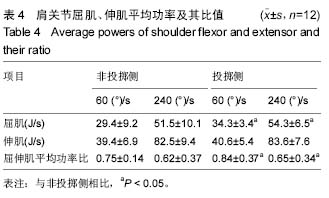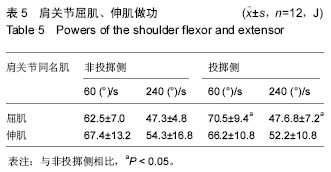3 分析与讨论 Analysis and discussion
3.1 肩关节屈伸肌肌力测试结果分析 使用等速测试系统对青少年垒球运动员肩关节屈伸肌肌力进行等速测试,能够找出同侧及两侧肩关节屈伸肌肌力存在的差异,有针对性的提高运动员的弱侧肌肉,防止肌力不平衡带来的运动损伤。
3.1.1 肩关节屈伸肌峰力矩测试结果分析 肌肉收缩属于肌肉生理学中的肌纤维收缩范畴。王端元等[1]对肌肉收缩过程的研究结果表明,肌肉收缩产生张力的生理学原理是肌纤维受到外界刺激时产生神经兴奋,神经兴奋经传入神经到达神经中枢,经过神经中枢的分析处理后再经传出神经将神经中枢的指令下达给效应器来完成肌肉收缩。李国平等[2]的研究认为,肌肉在向心收缩时,肌肉的收缩主要由肌纤维的收缩成分来承担,肌肉在进行快速收缩时,由于受到心理因素的上位中枢神经的限制,被调动起来参与肌肉收缩的肌纤维越少,因此产生的峰力矩也越小。从表1的研究结果可知,在对青少年垒球运动员两侧肩关节屈伸肌的等速测试中,在60 (°)/s和240 (°)/s的测试速度下,肩关节屈伸肌峰值力矩随着测试速度的增加而减小。国内外其他学者对髋关节、膝关节、肩关节屈伸肌峰值力矩的研究结果表明:慢速测试时,屈伸肌峰力矩值比较大,随着测试速度增加达到一定临界值速度时,屈伸肌峰力矩逐渐减小,整体上是随着测试速度的增加,屈伸肌峰力矩呈现下降趋势。荣丽[3]对中国国家队19名女子优秀体操运动员肩关节屈伸肌群在60 (°)/s和240 (°)/s的等动向心收缩肌力测试的研究中发现:女子体操运动员肩关节屈伸肌峰力矩随着测试速度的增加而减小。曹峰锐等[4]对广东省14名女子曲棍球运动员膝关节屈伸肌群在60,90和240 (°)/s的等速测试结果也证实女子曲棍球运动员膝关节屈伸肌峰力矩随着测试速度的增加而减小。因此,作者此次研究的研究结果与前人一致。
在同一测试速度下,青少年垒球运动员的同侧肩关节的伸肌峰值力矩大于屈肌峰值力矩,两者存在显著性差异(P < 0.05);投掷侧肩关节屈肌肌力明显大于非投掷侧(P < 0.05)。垒球运动和手球、皮划艇、体操等上肢关节运动的运动项目的发力有很多的相似,这3种运动它们的屈肌峰力矩都小于伸肌峰力矩。曹峰锐等[5]在对女子手球运动员肩关节屈伸肌群的等速测试中指出,在60 (°)/s和240 (°)/s 测试速度下,两侧肩关节屈伸肌峰力矩和相对峰力矩值均表现为伸肌群明显大于屈肌群,两侧肩关节伸屈肌峰力矩和相对峰力矩值经独立样本t检验差异非常显著(P < 0.01)。周小敏等[6]发现中国划艇运动员的屈肌力量明显不如伸肌力量,随着速度的增加伸肌力量下降较慢,而屈肌力量下降较快,导致屈伸比呈递减趋势,这显然不利于划艇动作的完成,也不利于技术动作的稳定发挥。吕万刚等[7]发现男子中级后期部分体操运动员肩关节伸肌力量强于屈肌,但在训练中都得到协调发展。另外还有其他一些相关研究对肩关节屈伸肌做了系统的实验证明肩关节屈肌和伸肌的峰力矩有明显差异。王希升等[8]对乒乓球、网球女运动员肩部肌群进行等速肌力测试,结果发现乒乓球、网球女运动员右肩(持拍侧)的力量均大于左肩(非持拍侧)的力量;但两者也有各自的特点,乒乓球运动员左右两肩旋内、旋外的力量差异显著;网球运动员左右两肩内收、外展的力量差异显著。丁浩男[9]在对大学生网球运动员肩关节屈伸肌在60 (°)/s和180 (°)/s的等速向心肌力的结果却与本文及前人研究结果截然相反,丁浩男的研究结果表明不管是在60 (°)/s还是180 (°)/s的测试情况下,大学生网球运动员屈肌的峰力矩明显大于伸肌。造成这种实验结果不同的原因一方面是测试速度和测试对象性别不一样,另一方面是两个实验的测试项目和运动员等级不一样。针对本实验测试结果以及垒球项目特征,作者认为在运动训练中教练员应着重加强青少年垒球运动员投掷侧屈肌力量的发展,这样有利于运动员进一步提高专项技术,提高投掷和挥棒速度。在同一测试速度下,青少年垒球运动员两侧肩关节伸肌的峰力矩不存在显著性差异 (P > 0.05)。这说明青少年垒球运动员经过常年系统的专项身体素质训练,肩关节伸肌肌力得到一定的提高,但是提高的不明显。尤其对于投掷侧来说,肩关节伸肌肌力的提高幅度没有屈肌提高幅度大,由此也可以说明垒球运动的发力主要是以投掷屈肌发力为主。
3.1.2 肩关节屈伸肌峰值力矩比值测试结果分析 关节屈伸肌峰力矩比值是运动训练中运动员选材和评定运动员肌力水平的重要指标,同时也是运动医学中指导患者肌力康复的重要指标,因此,关节屈伸肌峰力矩比值这一指标一直是这两大领域的重点研究课题之一。关节屈伸肌峰力矩比值是衡量肌肉屈伸肌力量是否平衡的重要指标,其比值的过小或者过大都会影响肌肉用力的协调性和肌肉力量的均衡性,决定着运动员在高强度训练和比赛中是否容易出现运动损伤。国外有关膝关节屈伸肌峰值力矩比值的研究结果显示,在60 (°)/s的慢速测试时,屈伸肌峰值力矩比值为60%-69%;在 180 (°)/s的中速测试时,屈伸肌峰值力矩比值为70%- 79%;在300(°)/s的快速测试时,屈伸肌峰值力矩比值为80%-95%。汪洋等[10]对中国10名奥运会集训队男子花剑运动员下肢等速肌力测试结果表明随着测试速度的增加前腿髋、膝、踝关节屈伸肌峰值力矩比在不断增加。郭黎等[11]对优秀击剑运动员肩关节等速肌力测试发现受试者双侧膝关节屈伸肌群峰力矩比值在240 (°)/s测试速度下大于60 (°)/s,即随着测试速度的增加膝关节屈伸肌峰值力矩比在增加。曹峰锐等[4]对广东省14名女子曲棍球运动员膝关节屈伸肌群在60,90和240 (°)/s的等速测试结果也证实女子曲棍球运动员膝关节屈伸肌峰力矩比值随着测试速度的增加而增加。
在此次试验中,青少年女子垒球运动员投掷侧肩关节屈伸肌峰力矩比值在快速测试时为74.55%,这个数值相对略低,而投掷侧肩关节屈伸肌峰力矩比值在慢速测试时偏高,说明青少年女子垒球员投掷侧肩关节屈肌快速力量偏低,伸肌最大力量比较低。纵观表2的实验结果可以看出,在60 (°)/s和240 (°)/s的测试速度下,随着测试速度的增加青少年垒球运动员两侧肩关节屈伸肌峰值力矩比值在减小,这与国内外前人对其他关节屈伸肌峰力矩比的研究结果截然相反,这可能与实验对象、测试项目和测试关节的不同有关。但是值得注意的是在同一项目的肩关节屈伸肌等速肌力测试研究中,郭明等[12]利用等速肌力测试系统对5名成年女子垒球投手肩关节屈伸肌进行的测试结果也表明垒球运动员肩关节屈伸肌峰值力矩比值在60 (°)/s时是75%,在 240 (°)/s的测试速度下时是83%,这不但与作者此次实验研究结果相反,而且测试值普遍高于本试验。究其原因可能与两个试验所采用的测试仪器和测试对象年龄不同有关,具体原因有待进一步深入研究。
针对此次研究结果可以得出一条规律:青少年垒球运动员肩关节屈伸肌峰值力矩比的变化趋势与肩关节屈伸肌峰值力矩的变化趋势是一致的,即随着等速测试速度的增加,青少年垒球运动员肩关节屈伸肌峰值力矩在减小,肩关节屈伸肌峰值力矩比值相应的也在减小。在同一测试速度下,青少年垒球运动员投掷侧肩关节的屈伸肌峰值力矩比明显大于左侧非投掷侧,二者存在显著性差异(P < 0.05),这种结果与运动员的专项训练有关,投掷侧肩关节是常用关节,经过长期的系统训练投掷侧肩关节屈伸肌力量都得到发展,但屈肌力量发展速度远远大于伸肌,因此投掷侧屈伸肌峰力矩比相对较大;而非投掷侧肩关节的训练较少,因此屈伸肌峰力矩比相对较小。
通过等速测试系统对青少年垒球运动员进行肩关节屈伸肌峰值力矩比值指标的测试,能够为更为准确、直观的评价青少年垒球运动员肩关节的稳定性以及为青少年垒球运动员肩关节运动损伤的预防和康复提供一定的评价标准。从表2的测试数据可以看到青少年垒球运动员的肩关节屈伸肌峰力矩比在70%-80%,这个数值是相当高的,这与运动员的专项用力特点和专项力量训练有关,青少年垒球运动员经过长期系统的专项力量训练,肩关节的屈肌肌力水平得到大幅度提高,而肩关节伸肌肌力水平较屈肌而言没有得到相同程度的提高。因此在垒球运动训练中,应继续保持加强投掷侧屈肌力量训练,但是又不能一味为了投球力量和速度来发展肩关节屈肌肌力,同时也要发展肩关节伸肌肌群的力量,实现肩关节屈伸肌肌力的平衡。
3.1.3 肩关节同名屈伸肌肌力测试结果分析 有关研究表明,两侧关节的同名肌肌力比的差异应该控在10%以内,否则弱侧肌肉容易出现拉伤。通过表3的测试结果发现,随着测试速度的增加,青少年垒球运动员同名屈伸肌肌力比在减小。王星[13]在对男子网球运动员肘关节屈伸肌群的等速测试研究结果也表明男子国家二级网球运动员左右侧同名屈伸肌肌力比随着测试速度的增大而减小,这说明本文研究结果与前人一致。在同一测试速度下,肩关节同名肌屈肌肌力比要大于伸肌肌力比。在60 (°)/s和240 (°)/s的测试速度时,肩关节同名侧伸肌肌力比分别为7.60%和6.05%,在10% 这个范围内;屈肌肌力比分别为12.27%和11.01%,超出了10%这个范围,这说明青少年垒球运动员投掷侧肩关节屈肌力量远远大于非投掷侧。出现这种结果的原因与垒球运动员的专项力量训练密切相关,青少年垒球运动员在日常力量训练中过多进行投掷侧肩关节力量训练而忽视对非投掷侧的肩关节力量训练,结果导致投掷侧的肩关节的屈肌力量明显大于非投掷侧。因此在对青少年垒球运动的专项力量训练中,应加强非投掷侧肩关节肌群的力量训练,减小两侧同名肌肌力的差异性。两侧肩关节屈伸肌力量的协调发展不仅有助于青少年运动员进一步学习专项技术,提高运动成绩,而且能够预防运动损伤。
目前对膝关节同名肌肌力比差异的研究较多,对肩关节同名肌肌力比差异的相关研究比较少,对肩关节同名肌肌力比差异合理大小的研究更是没有,有待进一步深入研究。
3.2 肩关节屈伸肌平均功率及平均功率比测试结果分析 功率是肌肉收缩时力与速度的乘积,是肌肉爆发力做功的表现。由功率公式P=f•v可知,要想提高肌肉的爆发力,训练内容必须是力与速度相结合的训练。平均功率是肌肉在单位时间内所做的功,反映肌肉的工作效率,在某种程度上能反映肌肉的快速力量。肌肉的最大功率是肌肉收缩的最快速度和肌肉最大力量1/3的乘积,约等于理想的最大功率的1/10。在一定范围内肌肉功率随着运动速度的增加而增加,但当肌肉运动速度达到一临界值时,功率反而随着运动速度的加快而下降。表4的研究结果显示,青少年垒球运动员肩关节屈伸肌做功平均功率在60 (°)/s和240 (°)/s的测试速度时,随着测试速度的增加而增加。俞小亚等[14]在对攀岩运动员肩关节屈伸肌等速肌力测试也同样发现肩关节屈伸肌平均功率值随测试速度的增加而增大。邹魁等[15]测得国家健将级男女柔道运动员膝关节伸肌在60 (°)/s测试速度下的平均功率为(118.0±31.4) J/s,在240 (°)/s测试速度下的平均功率为(170.1±45.2) J/s;膝关节屈肌在60 (°)/s测试速度下的平均功率为(81.4±26.6) J/s,在240 (°)/s测试速度下的平均功率为(122.1±29.9) J/s,其测试结果普遍远远大于本实验,其原因除了测试仪器的不同以及运动项目的差异,关节差异是主要原因,相对于肩关节而言,膝关节是强有力的大关节,其力量远远大于肩关节。
青少年女子垒球运动员肩关节平均功率的测试结果说明了青少年女子垒球运动员肩关节伸肌的快速力量强于屈肌。平均功率等于平均力与运动速度的乘积,肌肉在快速向心收缩时的峰力矩值小于慢速向心收缩,但在快速向心收缩时的平均功率值却大于慢速向心收缩。这主要是因为在快速收缩中,只有那些活动周期快的横桥参与活动,那些活动周期慢的横桥来不及活动,收缩就已结束,收缩速度越快,横桥形成的数量越少,力量也就越小。快速收缩时,尽管肌力减少,但速度增加的幅度大于肌力减少的幅度,所以快速收缩的平均功率值仍大于慢速收缩。
但是随着测试速度的增加屈伸肌平均功率比在减小,呈负相关,且肩关节的屈伸肌平均功率比在0.6-0.8之间。由此可以说,在60 (°)/s 和240 (°)/s的测试速度时,青少年垒球运动员肩关节屈伸肌做功平均功率比的发展趋势和肩关节屈伸肌峰值力矩的走向是一致的,肩关节屈伸肌峰值力矩在减小,平均做功功率比自然也跟着减小。在同一测试速度下,投掷侧肩关节屈肌平均功率明显大于非投掷,二者存在显著性差异(P < 0.05);投掷侧肩关节屈伸肌平均功率比明显要大于非投掷侧,二者具有显著性差异(P < 0.05)。由此而知,青少年垒球运动员投掷侧肩关节屈伸肌的爆发力明显大于非投掷侧。
3.3 肩关节屈伸肌做功测试结果分析 通过表5实验结果可知,青少年垒球运动员肩关节屈伸肌做功随着测试速度的增加而减小。根据做功公式W=F•S可知,在力的作用位移不变的前提下,峰力矩随着测试速度的增加而减小,那么做功也必然随着测试速度的增加而减小。同一测试速度下,青少年垒球运动员投掷侧屈肌做功明显大于非投掷侧屈肌做功(P < 0.05),投掷侧肩关节伸肌做功小于非投掷侧,二者不存在显著性差异(P > 0.05),这表明长期的力量训练使得青少年垒球运动员投掷侧肩关节屈肌力量得到了较大提高,而伸肌力量提高相对较小。 3.4 结论与建议 ①随着测试速度的增加,青少年垒球运动员两侧肩关节屈伸肌峰值力矩、屈伸肌峰值力矩比、同名侧屈伸肌肌力比、屈伸肌平均功率比、屈伸肌做功在减小,而屈伸肌平均功率在增加。②在同一测试速度下,投掷侧肩关节屈伸肌峰值力矩、屈伸肌峰值力矩比、屈伸肌平均功率、屈伸肌平均功率比、屈肌做功大于非投掷侧(P < 0.05),而投掷侧伸肌峰力矩、伸肌平均功率与非投掷侧伸肌相比没有显著性差异(P > 0.05);在同一测试速度下,两侧肩关节同名肌屈肌肌力比大于伸肌肌力比,投掷侧伸肌做功小于非投掷侧。③青少年垒球运动员肩关节屈伸肌力量发展极不平衡,表现出投掷侧屈伸肌肌力大于非投掷,同侧屈伸肌及两侧屈伸肌肌力发展不平衡,教练员应加强青少年垒球运动员弱侧肌肉力量,促进青少年垒球运动员肩关节肌肉力量的均衡发展,降低运动损伤风险。④青少年垒球运动员投掷侧肩关节屈肌快速力量偏低,伸肌最大力量比较低。
中国组织工程研究杂志出版内容重点:组织构建;骨细胞;软骨细胞;细胞培养;成纤维细胞;血管内皮细胞;骨质疏松;组织工程
.jpg) 文题释义:
等速肌力测试:又称调节抗阻运动或恒定角速度运动,关节在运动过程中,运动速度一旦预先设定,无论受试者肌肉收缩产生多大的张力,肢体的运动始终在某一预定的速度(等速)下进行,肌肉张力大小的变化并不能使肢体产生加速或减速的一种运动。
等速肌力测试仪:在测试过程中能够测量受试者整个运动范围内任何一点上肌肉(肌群)的最大力矩输出。等速运动时,肌纤维长度缩短或被拉伸,引起明显的关节活动,是一种动力性收缩,类似于等张收缩,但等速测试中,等速肌力测试仪器所提供的是一种顺应性阻力,阻力大小随肌肉收缩张力的大小而变化,又类似等长收缩。
文题释义:
等速肌力测试:又称调节抗阻运动或恒定角速度运动,关节在运动过程中,运动速度一旦预先设定,无论受试者肌肉收缩产生多大的张力,肢体的运动始终在某一预定的速度(等速)下进行,肌肉张力大小的变化并不能使肢体产生加速或减速的一种运动。
等速肌力测试仪:在测试过程中能够测量受试者整个运动范围内任何一点上肌肉(肌群)的最大力矩输出。等速运动时,肌纤维长度缩短或被拉伸,引起明显的关节活动,是一种动力性收缩,类似于等张收缩,但等速测试中,等速肌力测试仪器所提供的是一种顺应性阻力,阻力大小随肌肉收缩张力的大小而变化,又类似等长收缩。.jpg) 文题释义:
等速肌力测试:又称调节抗阻运动或恒定角速度运动,关节在运动过程中,运动速度一旦预先设定,无论受试者肌肉收缩产生多大的张力,肢体的运动始终在某一预定的速度(等速)下进行,肌肉张力大小的变化并不能使肢体产生加速或减速的一种运动。
等速肌力测试仪:在测试过程中能够测量受试者整个运动范围内任何一点上肌肉(肌群)的最大力矩输出。等速运动时,肌纤维长度缩短或被拉伸,引起明显的关节活动,是一种动力性收缩,类似于等张收缩,但等速测试中,等速肌力测试仪器所提供的是一种顺应性阻力,阻力大小随肌肉收缩张力的大小而变化,又类似等长收缩。
文题释义:
等速肌力测试:又称调节抗阻运动或恒定角速度运动,关节在运动过程中,运动速度一旦预先设定,无论受试者肌肉收缩产生多大的张力,肢体的运动始终在某一预定的速度(等速)下进行,肌肉张力大小的变化并不能使肢体产生加速或减速的一种运动。
等速肌力测试仪:在测试过程中能够测量受试者整个运动范围内任何一点上肌肉(肌群)的最大力矩输出。等速运动时,肌纤维长度缩短或被拉伸,引起明显的关节活动,是一种动力性收缩,类似于等张收缩,但等速测试中,等速肌力测试仪器所提供的是一种顺应性阻力,阻力大小随肌肉收缩张力的大小而变化,又类似等长收缩。



.jpg)
.jpg) 文题释义:
等速肌力测试:又称调节抗阻运动或恒定角速度运动,关节在运动过程中,运动速度一旦预先设定,无论受试者肌肉收缩产生多大的张力,肢体的运动始终在某一预定的速度(等速)下进行,肌肉张力大小的变化并不能使肢体产生加速或减速的一种运动。
等速肌力测试仪:在测试过程中能够测量受试者整个运动范围内任何一点上肌肉(肌群)的最大力矩输出。等速运动时,肌纤维长度缩短或被拉伸,引起明显的关节活动,是一种动力性收缩,类似于等张收缩,但等速测试中,等速肌力测试仪器所提供的是一种顺应性阻力,阻力大小随肌肉收缩张力的大小而变化,又类似等长收缩。
文题释义:
等速肌力测试:又称调节抗阻运动或恒定角速度运动,关节在运动过程中,运动速度一旦预先设定,无论受试者肌肉收缩产生多大的张力,肢体的运动始终在某一预定的速度(等速)下进行,肌肉张力大小的变化并不能使肢体产生加速或减速的一种运动。
等速肌力测试仪:在测试过程中能够测量受试者整个运动范围内任何一点上肌肉(肌群)的最大力矩输出。等速运动时,肌纤维长度缩短或被拉伸,引起明显的关节活动,是一种动力性收缩,类似于等张收缩,但等速测试中,等速肌力测试仪器所提供的是一种顺应性阻力,阻力大小随肌肉收缩张力的大小而变化,又类似等长收缩。